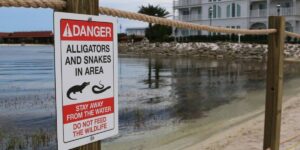SeaWorld is facing a major change.
For decades, SeaWorld has pulled in millions of guests every year with a combination of animal encounters, thrill rides, and live entertainment. In recent years, however, the prominence of marine mammals at its theme parks – particularly its orcas (aka killer whales) and dolphins – has drawn more controversy than it has praise, with Blackfish (2013) reframing the way many think about keeping these animals in captivity.

In the wake of the documentary’s release, SeaWorld has faced ongoing criticism over its treatment of orcas, alongside a drop in attendance. The company has since ended its orca breeding program and confirmed that the current generation will be the last to live in its parks. It has also outlined its reasons for not releasing the animals into the wild. Still, animal rights groups continue to pressure SeaWorld Orlando, San Diego, and San Antonio to go further.
Orcas, however, aren’t the only source of controversy at SeaWorld’s parks.
SeaWorld Faces Increased Pressure to Axe Fireworks
SeaWorld is currently being pressured by animal rights activists to put an end to a decades-old source of entertainment: its fireworks.
Its Southern California theme park has been heavily criticized for its decision to run pyrotechnics throughout the summer. The San Diego Humane Society has argued that its summer fireworks show, Enchanted Wonders, is wreaking havoc on local wildlife.

“Fireworks create loud explosions and bright flashes that can be terrifying for animals,” its director of public relations, Nina Thompson, told The Times of San Diego. “Wildlife also suffers, with birds and other animals being disoriented and injured by the sudden noise and light. The trauma experienced by animals – both domestic and wild – can have lasting effects, from anxiety to physical harm,” Thompson said.
District 1 City Council Joseph LaCava has also criticized the shows. “The fireworks over Mission Bay night after night must come to an end,” he said. “Massive explosions 150 nights a year impose too great an impact on residents and the environment, and the influx of complaints from residents to my office is proof of that.”
This isn’t the first time that groups have resisted SeaWorld’s fireworks. Earlier this year, San Diego Coastkeeper and CERF sued SeaWorld, claiming that the park agreed to cleanup rules in a previous settlement over a decade ago and has since failed to meet these terms.
“They are not cleaning up the fireworks debris and the trash and the plastics that are a result of these shows,” Executive Director of San Diego Coastkeeper Phillip Musegaas said (via ABC 10News San Diego). The group reportedly sent divers to the park’s fireworks barge, where they found an abundance of plastic wires and fireworks caps.
The 40-page lawsuit claims that SeaWorld is violating the Clean Water Act and accuses the park of not conducting Mission Bay cleanups after its shows. Both groups are calling for SeaWorld to rethink its entertainment – ideally axing fireworks in favor of a more environmentally friendly alternative.
Last summer, the San Diego Audubon Society called for the California Coastal Commission to revoke SeaWorld San Diego’s fireworks permit through most of the breeding season due to an increase in bird deaths in the area.

The group claimed that a significant number of dead unborn, chick and adult elegant terns – a breed primarily found on the Pacific coast and defined as “near threatened” by the International Union for Conservation of Nature – washed ashore at the Kendall-Frost Marsh Reserve, a mere few days after SeaWorld San Diego and Discover Mission Bay detonated over 500 pounds of pyrotechnics for the Fourth of July.
The San Diego Audubon Society reportedly sent a letter to the California Coastal Commission with their complaints, complete with images of the birds that were allegedly flying over the island during the fireworks, plus photos of the “panic flights of huge flocks of terns of 5,000-7,000 flying around during and after the show notably on July 4,” and the carcasses found after the event.
Alternatives to Fireworks
Instead of fireworks, The San Diego Humane Society has called for SeaWorld San Diego to embrace drone shows, much like the daily entertainment currently found at SeaWorld Abu Dhabi. “In contrast, drone light shows provide a stunning visual experience without the noise and disruption that fireworks cause,” Thompson said. “These modern displays can still bring communities together for a celebration, all while protecting the welfare of animals and reducing environmental harm.”

Other theme parks have also embraced drone shows over fireworks in recent years. That includes Disneyland Paris – which still maintains a fireworks show, but has increasingly leaned on the technology for an added wow factor for the likes of Disney’s Electrical Sky Parade – and Walt Disney World Resort, which ran a free drone show at Disney Springs for the summer of 2024.
Another alternative is projection mapping. Disneyland Resort, which has also had to contend with the views of local residents, performs its own fireworks show sans pyrotechnics on select nights to reduce both noise and pollution. Instead, projections on Main Street, U.S.A. and Sleeping Beauty Castle are the main attraction.
Do you think it’s time for theme parks to cut down on fireworks?
The post SeaWorld’s Future in Question as Pressure Mounts appeared first on Inside the Magic.



